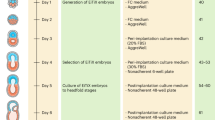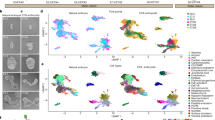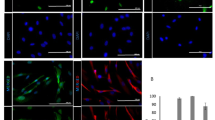Abstract
A highly enriched population of neural crest cells (NCCs) from amniote embryos, such as from chicks, mice and humans, is desirable for experiments in fate determination. NCCs are also useful for testing the functional effects of molecular changes underlying numerous human diseases of neural crest derivatives and for investigating their potential for therapeutic compensation. This protocol details embryonic microdissection followed by neural tube explantation. Conditions favoring NCC expansion and the maintenance of their stem cell–like properties are described. Although neural crest–like cells can be derived from a number of sites in the mature organism, full potential is best ensured by their purification from their source tissue at the outset of migration. Going from embryo to established cell line takes 4 d; the first is the most labor-intensive day, but minimal intervention is required thereafter.
This is a preview of subscription content, access via your institution
Access options
Subscribe to this journal
Receive 12 print issues and online access
$259.00 per year
only $21.58 per issue
Buy this article
- Purchase on Springer Link
- Instant access to full article PDF
Prices may be subject to local taxes which are calculated during checkout



Similar content being viewed by others
Change history
11 October 2013
In the version of this article initially published, the descriptions of how to make FGF and complete NCC culture medium were incorrect. The text initially read "FGF (2.5 µg ml–1): Use 4 ml 10% (wt/vol) BSA solution to dissolve 25 µg of FGF." In addition, in the details for making complete NCC culture medium, the text initially read "Add 1 µl of EGF (2.5 µg ml–1) and 8 µl of FGF (10 µg ml–1)." The phrase about FGF should have read "FGF (2.5 µg ml–1): Use 4 ml 10% (wt/vol) BSA solution to dissolve 10 µg of FGF." For complete NCC culture medium, the text should have read "Add 1 µl of EGF (10 µg ml–1) and 8 µl of FGF (2.5 µg ml–1)." The errors have been corrected in the HTML and PDF versions of the article.
References
Le Douarin, N. & Kalcheim, C. The Neural Crest (Cambridge University Press, 1999).
Roux, W. Beiträge zur entzicklungsmechanik des embryo. Zeitschrift fuer Biologie 21, 411 (1885).
Harrison, R.G. The outgrowth of the nerve fiber as a mode of protoplasmic movement. J. Exper. Zool. 9, 787–846 (1910).
Pannett, C.A. & Compton, A. The cultivation of tissues in saline embryonic juice. Lancet 203, 381–384 (1924).
Sieber-Blum, M. & Cohen, A. Clonal analysis of quail neural crest cells: they are pluripotent and differentiate in vitro in the absence of noncrest cells. Dev. Biol. 80, 96–106 (1980).
Smith-Thomas, L.C. & Fawcett, J.W. Expression of Schwann cell markers by mammalian neural crest cells in vitro. Development 105, 251–262 (1989).
Baroffio, A., Dupin, E. & Le Douarin, N.M. Common precursors for neural and mesectodermal derivatives in the cephalic neural crest. Development 112, 301–305 (1991).
Boot, M.J. et al. Spatiotemporally separated cardiac neural crest subpopulations that target the outflow tract septum and pharyngeal arch arteries. Anat. Rec. 275, 1009–1018 (2003).
Morrison, S.J. et al. Prospective identification, isolation by flow cytometry, and in vivo self-renewal of multipotent mammalian neural crest stem cells. Cell 96, 737–749 (1999).
Perris, R. et al. Molecular mechanisms of neural crest cell attachment and migration on types I and IV collagen. J. Cell. Sci. 106, 1357–1368 (1993).
Stemple, D.L. & Anderson, D.J. Isolation of a stem cell for neurons and glia from the mammalian neural crest. Cell 71, 973–985 (1992).
Karbanová, J. et al. Characterization of dental pulp stem cells from impacted third molars cultured in low serum-containing medium. Cells Tissues Organs 193, 1–22 (2010).
Miura, M. et al. SHED: stem cells from human exfoliated deciduous teeth. PNAS 100, 5807–5812 (2003).
Stevens, A. et al. Human dental pulp stem cells differentiate into neural crest-derived melanocytes and have label-retaining and sphere-forming abilities. Stem Cells Dev. 17, 1175–1184 (2008).
Coura, G.S. et al. Human periodontal ligament: a niche of neural crest stem cells. J. Periodontal Res. 43, 531–536 (2008).
Kruger, G.M. et al. Neural crest stem cells persist in the adult gut but undergo changes in self-renewal, neuronal subtype potential, and factor responsiveness. Neuron 35, 657–669 (2002).
Li, H.-Y., Say, E.H.M. & Zhou, X.-F. Isolation and characterization of neural crest progenitors from adult dorsal root ganglia. Stem Cells 25, 2053–2065 (2007).
Coulpier, F. et al. Novel features of boundary cap cells revealed by the analysis of newly identified molecular markers. Glia 57, 1450–1457 (2009).
Lee, G. et al. Isolation and directed differentiation of neural crest stem cells derived from human embryonic stem cells. Nat. Biotech. 25, 1468–1475 (2007).
Kawaguchi, J. et al. Isolation and propagation of enteric neural crest progenitor cells from mouse embryonic stem cells and embryos. Development 137, 693–704 (2010).
Nagoshi, N. et al. Ontogeny and multipotency of neural crest-derived stem cells in mouse bone marrow, dorsal root ganglia, and whisker pad. Cell Stem Cell 2, 392–403 (2008).
Sviderskaya, E.V. et al. Functional neurons and melanocytes induced from immortal lines of postnatal neural crest-like stem cells. FASEB J. 23, 3179–3192 (2009).
Biernaskie, J.A. et al. Isolation of skin-derived precursors (SKPs) and differentiation and enrichment of their Schwann cell progeny. Nat. Protoc. 1, 2803–2812 (2006).
Wong, C.E. et al. Neural crest-derived cells with stem cell features can be traced back to multiple lineages in the adult skin. J. Cell Biol. 175, 1005–1015 (2006).
Sieber-Blum, M. et al. Pluripotent neural crest stem cells in the adult hair follicle. Dev. Dyn. 231, 258–269 (2004).
Fernandes, K.J.L. et al. A dermal niche for multipotent adult skin-derived precursor cells. Nat. Cell Biol. 6, 1082–1093 (2004).
Clewes, O. et al. Human epidermal neural crest stem cells (hEPI-NCSC)-characterization and directed differentiation into osteocytes and melanocytes. Stem Cell Rev. published online, 10.1007/s12015-011-9255-5 (1 April 2011).
Abzhanov, A. et al. Dissimilar regulation of cell differentiation in mesencephalic (cranial) and sacral (trunk) neural crest cells in vitro. Development 130, 4567–4579 (2003).
McGonnell, I.M. & Graham, A. Trunk neural crest has skeletogenic potential. Curr. Biol. 12, 767–771 (2002).
Fontaine-Pérus, J. & Chéraud, Y. Mouse-chick neural chimeras. Int. J. Dev. Biol. 49, 349–353 (2005).
de Pontual, L. et al. Epistasis between RET and BBS mutations modulates enteric innervation and causes syndromic Hirschsprung disease. PNAS 106, 13921–13926 (2009).
Thomas, S. et al. Human neural crest cells display molecular and phenotypic hallmarks of stem cells. Hum. Mol. Genet. 17, 3411–3425 (2008).
Lahav, R. et al. Endothelin 3 selectively promotes survival and proliferation of neural crest-derived glial and melanocytic precursors in vitro. PNAS 95, 14214–14219 (1998).
Dahéron, L. et al. LIF/STAT3 signaling fails to maintain self-renewal of human embryonic stem cells. Stem Cells 22, 770–778 (2004).
Wakamatsu, Y. et al. Regulation of the neural crest cell fate by N-myc: promotion of ventral migration and neuronal differentiation. Development 124, 1953–1962 (1997).
Hu, Y.F., Zhang, Z.-J. & Sieber-Blum, M. An epidermal neural crest stem cell (EPI-NCSC) molecular signature. Stem Cells 24, 2692–2702 (2006).
Rao, M.S. & Anderson, D.J. Immortalization and controlled in vitro differentiation of murine multipotent neural crest stem cells. J. Neurobiol. 32, 722–746 (1997).
Terayama, K. et al. Cloning and functional expression of a novel glucuronyltransferase involved in the biosynthesis of the carbohydrate epitope HNK-1. PNAS 94, 6093–6098 (1997).
Bakker, H. et al. Expression cloning of a cDNA encoding a sulfotransferase involved in the biosynthesis of the HNK-1 carbohydrate epitope. J. Biol. Chem. 272, 29942–29946 (1997).
Ito, K., Morita, T. & Sieber-Blum, M. In vitro clonal analysis of mouse neural crest development. Dev. Biol. 157, 517–525 (1993).
Garcez, R.C. et al. Epidermal growth factor (EGF) promotes the in vitro differentiation of neural crest cells to neurons and melanocytes. Cell Mol. Neurobiol. 29, 1087–1091 (2009).
Pla, P. et al. Ednrb2 orients cell migration towards the dorsolateral neural crest pathway and promotes melanocyte differentiation. Pigment Cell Res. 18, 181–187 (2005).
Campos, P.B. et al. Chromosomal spread preparation of human embryonic stem cells for karyotyping. JoVE doi:10.3791/1512 (2009).
Theiler, K. The House Mouse: Atlas of Embryonic Development (Springer-Verlag, 1989).
Hamburger, V. & Hamilton, H.L. A series of normal stages in the development of the chick embryo. 1951. Dev. Dyn. 195, 231–272 (1992).
O'Rahilly, R. & Müller, F. Developmental Stages in Humans: Including a Revision of Streeter's 'Horizons' and a Survey of the Carnegie Collection (Carnegie Institution of Washington, 1987).
White, R.M. et al. DHODH modulates transcriptional elongation in the neural crest and melanoma. Nature 471, 518–522 (2011).
Echelard, Y., Vassileva, G. & McMahon, A.P. Cis-acting regulatory sequences governing Wnt-1 expression in the developing mouse CNS. Development 120, 2213–2224 (1994).
Acknowledgements
H.E. has been supported by the Sturge-Weber foundation (2001), the INSERM Avenir program (2002–2005), the Fondation pour la Recherche Médicale (DEQ20071210511), the Agence Nationale pour la Recherche (ANR2007-CRANIRARE) and Nevus Outreach. In addition to all the authors who have developed the neural crest culture protocols referenced herein and to the directors of INSERM U781 and U910 who have made it possible for me to obtain embryonic tissues over the years, I extend my particular gratitude to E. Dupin, C. Glavieux-Pardanaud, A. Gonçalves-Trentin, S. Thomas and C. Ziller for aiding me in optimizing conditions.
Author information
Authors and Affiliations
Corresponding author
Ethics declarations
Competing interests
The author declares no competing financial interests.
Rights and permissions
About this article
Cite this article
Etchevers, H. Primary culture of chick, mouse or human neural crest cells. Nat Protoc 6, 1568–1577 (2011). https://doi.org/10.1038/nprot.2011.398
Published:
Issue Date:
DOI: https://doi.org/10.1038/nprot.2011.398
This article is cited by
-
An epigenetic switch controls an alternative NR2F2 isoform that unleashes a metastatic program in melanoma
Nature Communications (2023)
-
Glycan Epitope and Integrin Expression Dynamics Characterize Neural Crest Epithelial-to-Mesenchymal Transition (EMT) in Human Pluripotent Stem Cell Differentiation
Stem Cell Reviews and Reports (2022)
-
MESP2 variants contribute to conotruncal heart defects by inhibiting cardiac neural crest cell proliferation
Journal of Molecular Medicine (2020)
-
Histone demethylase KDM6B has an anti-tumorigenic function in neuroblastoma by promoting differentiation
Oncogenesis (2019)
-
Heterogeneity of neuroblastoma cell identity defined by transcriptional circuitries
Nature Genetics (2017)
Comments
By submitting a comment you agree to abide by our Terms and Community Guidelines. If you find something abusive or that does not comply with our terms or guidelines please flag it as inappropriate.



